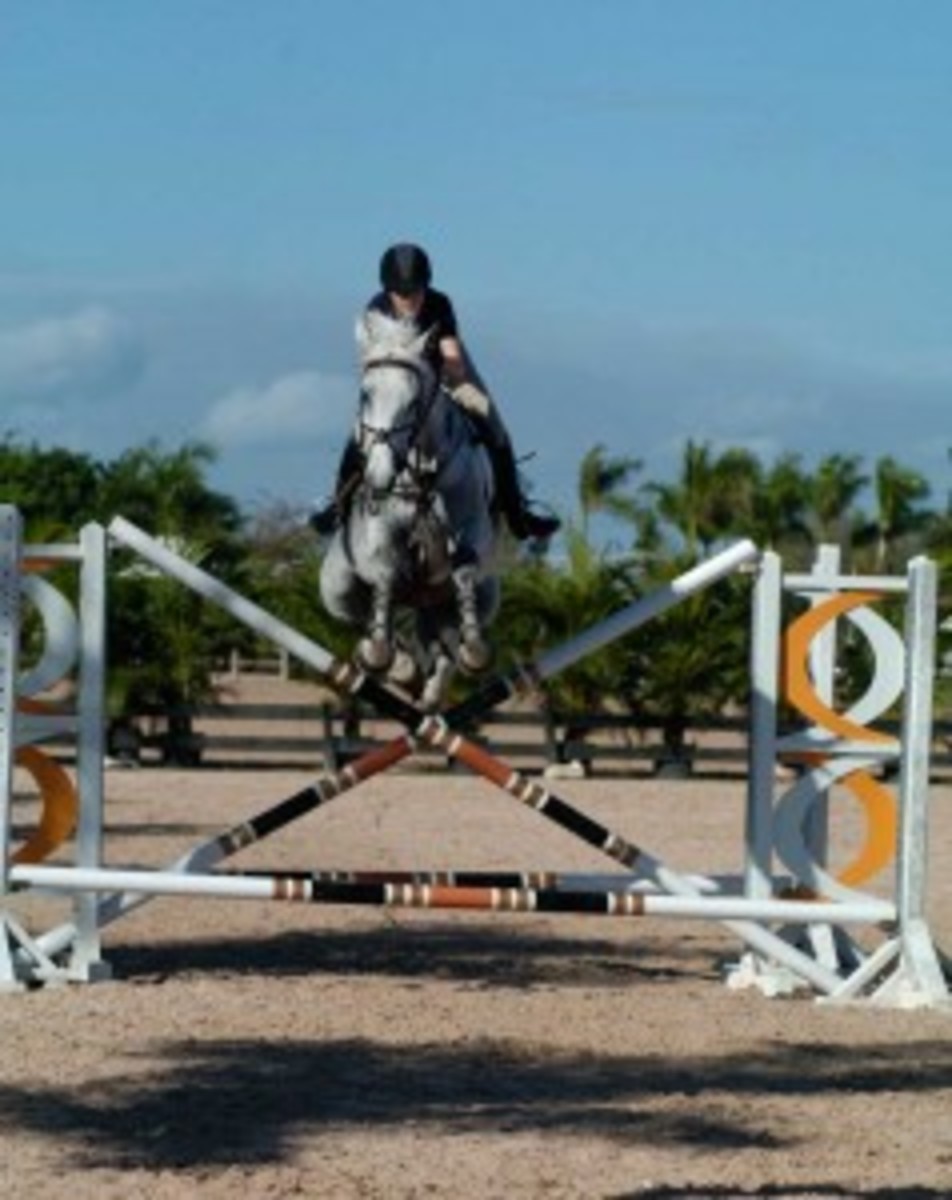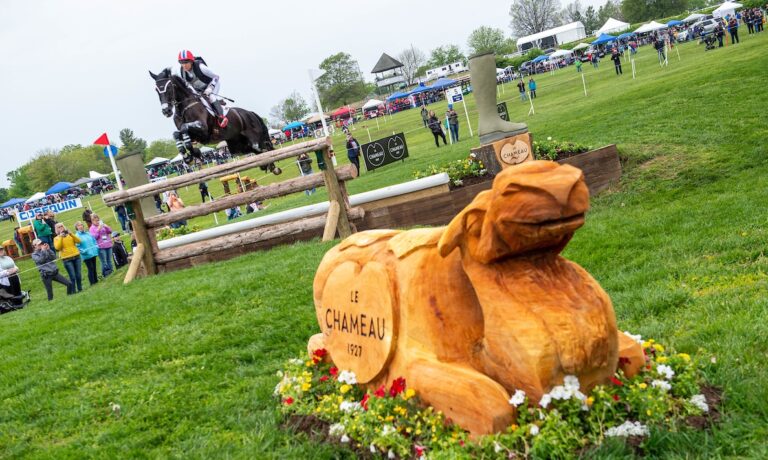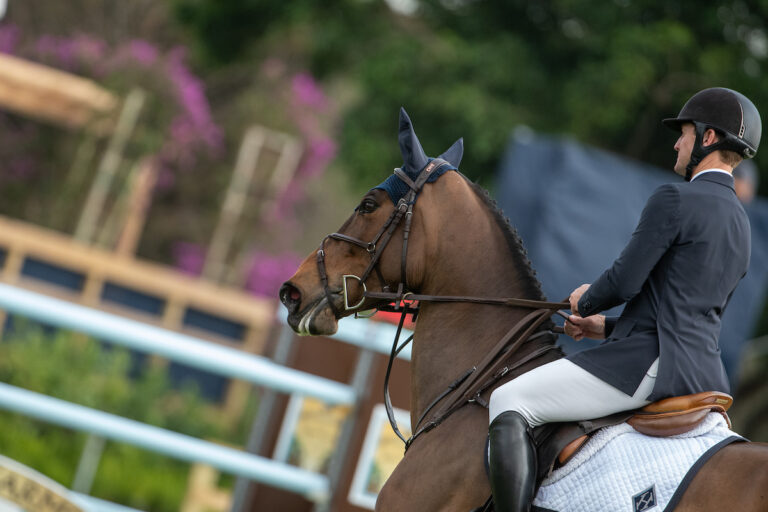George Morris continued to train 12 young riders in the third day of a comprehensive five-day training session on horsemastership that is being held at the Palm Beach International Equestrian Center in Wellington, Florida, this week. The riders were divided into two groups, with the first six riding at 8 a.m. and the next six riding at about 11 a.m. The riders had been selected to participate based on their performances in equitation, jumper and hunter competitions throughout 2013.

The day?s work focused on flatwork and gymnastic jumping exercises.
Flatwork
George started by lining the six riders in the first session and quizzing them on the German Training Scale, which, he relayed, is rhythm, looseness, contact, impulsion and collection.
He stressed that collection is always at the end of the list, but that ?I put impulsion first. I want the horse to think forward first. Is the horse thinking forward to the water [jump]? That’s impulsion.?
He then sent riders out onto a small circle and had them walk on a loose rein while he stressed impulsion, along with rhythm and regularity. Then there was another quick quiz about the tempo of the walk (4 beats) the trot (two beats) and the canter (three beats).
Create Impulsion to Create Contact
George wanted riders to use their legs to create impulsion while keeping their hands up over the horses? withers in a straight line with the bit, and he even walked alongside some of them holding their hands in the correct position so they could feel the contact. As he walked beside Victoria ?Tori? Colvin?s horse, Don Juan, for example, he told her to raise her hands and urge with her leg. ?You use your leg until he takes the bridle and stretches to the hand,? he said to the 16-year-old rider from Loxahatchee, Florida. ?This is contact.? He told Liza Finsness, 19, of Wellington, Florida, that when her horse, Shiver, resisted by raising his head, she needed to raise her hands, close her fingers and push with her leg. ?You have to resist the horse’s resistance, so the horse starts to accept contact.? But when Shiver softened in the mouth, he told her to be sure to give with her hands. He also encouraged Michael Hughes, 17, of Allendale, New Jersey, to have loose elbows and allow them to oscillate at the walk to follow the motion of his horse.
?If you create impulsion, rhythm, looseness, in the end, You’ll produce contact, which is step toward collection,? he said, adding that, ?Every exercise on a horse is aimed at collection.?
Lateral Work and Bending Lines to Supple
As the riders moved on to a bigger circle and asked their horses to trot, George reminded them to use their inside legs to outside reins to straighten their horses.
On the curved line of the circle, he told them to think about using the inside leg at the girth to bend the horse and outside leg behind the girth. He then had them work on trot?halt?trot transitions, making sure to use their legs and keep the contact. As Tori worked, he reminded her to frequently touch her horse’s sides with her inside spur and close her outside hand, so he would round.
Next up was some lateral work to encourage the horses to be submissive to the riders? legs. George instructed the riders to work on shoulder-out on the long sides of the arena. As the riders worked around the arena to the left, he told them to use their right hands to flex the horses and their right legs to move them into their left hands. On the short sides, they would ride shoulder-in. After a few minutes, they rode a working trot, which has a ?little more vigor? than the warm-up trot and changed direction. Then it was sitting trot and haunches-out on the arena?s short sides and shoulder-out on the long sides. Throughout this, George warned riders not to drop their hands.
Riders then trotted over two cavalletti set on a short bending line. They approached it on the right rein, trotted over the first cavalletti, rode the bending line to the left, trotted over the second cavalletti and turned to the right. The changing directions helped to supple the horses. George wanted the riders to approach the exercise in a regular rhythm. He then asked them to walk, but maintain the forward impulsion at the walk. ?Most horses walk atrociously,? he said.
Spiral-in at the Canter
In the canter work that followed, George had the riders spiral in on three circles with the horses? haunches displaced slightly in and their bodies bent around the riders? inside legs. To turn the horse, he said the riders should use both hands and the outside leg. Then when the horses relaxed a little, he said they could ?give slightly with their inside reins while the outside rein remained more solid. The riders then changed direction and repeated the exercise. George says he does the spiral-in work at the walk and canter but not the trot where it would turn into a little piaffe and passage.
After the spiral-in exercise, the riders rode a transition to walk and George reminded them again to ?make every transition count.? He wanted the horses uphill in the transition and in front of the riders? legs. In the walk, he wanted the horses to be self-lively.
In addition to demanding the focus of the riders, George insisted that auditors show him the same respect. When he walked over to the group sitting under a small tent and saw one in the front row texting, he admonished him and sent him away, saying, ?Don?t waste my time.?
Straight Flying Changes
Then George moved on to flying-change work. He had the riders make big half turns and ask for flying changes. He said that many horses today do not sit down during flying changes but are high in their croups and sulky. To fix that, he wanted the riders to sit down in the half turn so the horses would learn to accept the seat and not pull the riders out of the saddle. Then he wanted the riders to keep the horses absolutely straight using the inside leg at the girth to outside rein. When the riders asked for the change, he told them to just change their aids, moving their new inside leg to the girth and taking a feel of the new outside rein. The inside leg pushes, especially if the horse kicks out or is high in the croup, and the outside leg is back and passive. He said too many people just grab the new inside rein to ask for the change, which makes the horse crooked and often late with the change behind. If a horse got quick after the change, he told the rider to half-halt him. This work started to encourage the horses to drop their croups and make the changes from behind.

George Rides
After the canter work, George got on Michael?s horse and jumped a crossrail. He jumped slightly ahead with his upper body, releasing only slightly. He said he was imitating Michael, whom he said does the work of his hands with his upper body. ?it’s subtle, but I would note it.? Instead, George wanted Michael to yield with his hands on every horse he rode and, if necessary, close his leg. ?Those are the only two things you do. Your seat does nothing. Your upper body does nothing. Your horse does it.?

George imitated another rider who sat too upright on her horse’s back. Instead, he wanted the riders to be light on their horses? backs to gallop and jump. ?Watch [Olympian] Nick Skelton,? George said. ?He is a master because so much of the time, He’s over his horse letting his horse do his job.?
George showed that he loves riding, when he said to Michael as he dismounted, ?I like this horse so much, I hate to give him back.?
While George was tough on the riders, he also showed a humorous side. When he asked the riders for observations of his riding, he quipped that Tori observed that he is still jumping. ?Tori said, ?He can jump? I just thought he taught,?? George chuckled. ?SHe’s in total shock.??
Jumping
George then moved on to having the riders jump several gymnastic elements. ?Through gymnastics, the horse learns to set himself.?
Theystarted over a triple bar on the short side of the arena. He wanted to riders to get sufficient pace to the jump, cut the corner a little and let the horses go forward to it. That work helped produce impulsion and looseness. ?As I let the horse go forward, I measure the fence,? he said. When the riders saw a distance, he told them to ride forward past it just a bit so that the horse jumped up from the base of the fence. ?Pace to the base,? he explained.

As the riders asked for pace, George also wanted them to stay light in their seats and forward with their upper bodies so they wouldn?t disturb their horses? self-carriage. ?If you don’t have to be defensive, stay forward,? he said.
After the jump, he had the riders half-halt and ride through the turn using the inside leg to outside rein.
Next the riders worked on a bending line of a liverpool to a vertical jump that was set at 52 feet from the liverpool?s outside corner to the vertical?s outside corner. He told the riders to ride the outside part of the line in four strides. He said fitting in the four quiet strides teaches the horse to collect. After the horses did this, he told the riders to open up the horses? stride and jump the line in three strides, which is a little easier because it’s freer. After riding the three stride, he would have them stop and back the horse, then ride the four stride again.
If a horse raised his head or twisted when fitting in the four strides, George told the rider not to ?freak out? and lose her position and give up. Instead he wanted the riders to stick to their guns and keep asking the horses to fit in the strides. ?You?ve got to ride well to jump well.?

Just as George wanted on the flat, his goal was for the horses to jump in self-carriage??that the horse does it for us. We don’t do it for them.? He said riders too often try to protect their horses and keep them in cocoons.
George then included the triple bar and the bending line in a little course. He had the riders start with the triple bar on the short side, which forced them to have a little pace and impulsion. Then they rode a left turn to the bending four-stride line to ask the horse to collect. Then they galloped and rode a large right turn back to a liverpool-to oxer line set at 37 feet in a long two strides. They then rode a wide left turn to a plank vertical and four long strides to a wide water jump. Then the riders were to stop their horses before turning.
Much of George?s instructions were the same throughout the course: Stay in a light seat, ask for pace to the first jump, work at fitting in the four strides. For the water jump, he told them to ride to the tape at the front of the water.
After the riders jumped the course, George raised the fences and added a vertical set on a bending seven-or eight-stride line after the water. It was set near the arena fence and he wanted the riders to make a sharp turn to the left and start the course again. He said because the fences were higher, riders would ride the first line in three strides.

At the end of the course, George had the riders make a circle, staying off their horses? backs, using the inside leg to outside rein and giving and taking on the inside rein slightly to soften their horses.
He ended the session, jumping a very big crossrail that was ?ugly? but simple and invited straightness. When one of the riders missed her distance to the jump, George said, ?If the distance is difficult people, work it out. Don?t quit.? He said to hold the horse a little and use leg to help him. You can’t get to the off-stride and be soft.
The second session included much of the same work and George reminded riders that ?Training is breaking up the resistances in the horse.?
The George H. Morris Horsemastership Training Session is presented by the U.S. Hunter Jumper Association and supported by the U.S. Equestrian Federation, the U.S. Equestrian Team Foundation, Practical Horseman and the Winter Equestrian Festival.
To watch the riding sessions live or on demand, go to www.usefnetwork.com.










